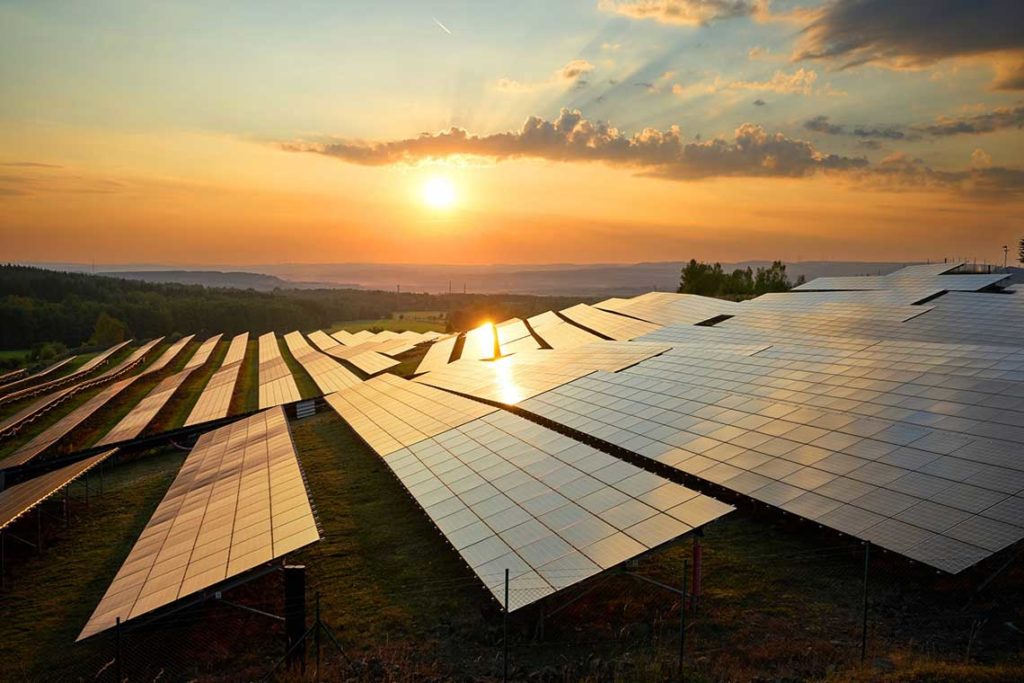
Image: Getty.
The UK solar industry needs to treble in size to align with Climate Change Committee (CCC) recommendations, hitting 40GW of installed capacity by 2030.
In Solar Energy UK’s new report, Lighting the Way, it outlines the policy and regulatory changes needed to drive the adoption of solar over the next eight years. According to the CCC’s most recent carbon budget, by 2035 solar and wind together need to make up 75-90% of the UK’s electricity mix. This will require solar alone to generate 60TWh per year.
The solar sector in the UK is a success story the report states, and despite the end of all subsidies in 2019 the sector has continued to grow, with 14GW of operational capacity and an increasing rate of growth. But barriers remain, preventing it from truly reaching its full potential.
Companies around the country are in a strong position to deliver the necessary growth, said Solar Energy UK chief executive Chris Hewett, “however, the Government must act now to accelerate deployment to ensure their net zero targets are met. Jobs, economic growth, and a massive reduction in carbon emissions are all up for grabs.”
Without any reforms from government and within a business as usual scenario, solar capacity is set to double to 28.6GW by 2030, driven by an annual deployment rate of 1.5GW a year with a compound annual growth rate (CAGR) of 7%. This highlights the strength of the sector even in the absence of government subsidy, but will leave the UK more than 11GW shy of the level needed for it to hit its net zero targets.
The report details four scenarios, with a low ambition scenario where the government makes superficial policy changes, a moderate ambition where the government makes supportive policy changes, and finally a net zero scenario where the government uses solar to its full potential.
If the UK could treble its solar capacity to 40GW through an annual increase in capacity of 3GW, this would equate to cutting 4.7% of the country’s emissions from 2019 levels, deliver 13,000 jobs, create £17 billion in additional economic activity and include a CAGR of 11%, the report shows.
Utility-scale solar reforms
The support required for each segment of the solar sector to reach net zero varies. Utility-scale solar needs to grow to 25GW by 2030, with Solar Energy UK highlighting the Contracts for Difference (CfD) scheme, planning and the Nationally Significant Infrastructure Project (NSIP) 50MW threshold, network charging and business rates as areas that need reform.
Pot One CfD auctions were reintroduced last year, following years of solar and onshore wind being excluded from the mechanism. Solar Energy UK is calling for auctions to be held at least annually until 2030 beginning from AR5. A robust budget and capacity cap should be brought in, and the government should use the auctions to provide certainty to the industry.
For the NSIP threshold, MWp AC should be clarified as the correct definition for solar projects, Solar Energy US continued. Beyond this, the Access and Forward Looking Charges Significant Code Review should look to establish a shallower distribution connection charging boundary.
This is a key barrier for the deployment of solar in the UK, as Cam Witten, policy manager at Solar Energy UK, stated in a launch event for the report today (17 June).
“This is a tough one to pin down in terms of capacity,” he said. “But the availability of grid is a huge potential barrier if it doesn’t keep pace with the level of deployment that we’re seeing coming forward.
“Anecdotally, what we’ve heard from members is that roughly 100 to 300 megawatts of additional capacity is probably being lost every year due to the current network charging regime. Now, some members have said quite conservative, and the number could be a lot higher than this. But it’s difficult to know because the current charging regime is such that a lot of sites will just look at the grid options, and not even come forward in the first instance, because the economics are untenable.”
The call for business rates changes has been highlighted by the association previously, there is a need for the Valuation Office to agree reduced rateable values for solar assets as it currently doesn’t reflect the economics of the post-subsidy market.
Commercial-scale solar reforms
Within the commercial-scale solar segment, changes to business rates are also a key reform needed to reach net zero. This segment needs to grow to 6.8GW in order for the UK to reach net zero according to Solar Energy UK’s research, and to do so solar and storage assets should be removed from the plant and machinery tables under Class 1 in the regulations (SI2000/540).
The call to change business rates has grown louder in recent times, in particular following reports last year that supermarket chain Lidl for example saw its business rates increase by 528% due to changes in the valuation of solar installations at its sites.
Beyond this change, capital allowances on solar investments should be extended out to 2030 said Solar Energy UK. Additionally the Public Sector Decarbonisation Scheme or an equivalent mechanism should also be extended out to the end of the decade as well.
Finally, the Future Buildings Standard should align with the Future Homes Standard reforms, meaning there is a minimum uplift of 31% in energy efficiency requirements. This is currently scheduled for 2025, with an increased target of 75-80% from 2028.
There is a lot of engagement between solar players and the commercial sector, panellists at today’s launch agreed. The three main types of companies looking to solar are retail, manufacturing and public sector, said Christelle Barnes, country manager for SolarEdge.
“I think manufacturing is a sector that’s been very strong for a while as high energy users,” she said. “And they often will have some restriction on the grid connection, which limits them from growing. And solar – potentially also with battery storage – allows them to bypass some of those limitations that may exist.”
Residential rooftop solar reforms
The final segment is residential-scale rooftop solar, which needs to grow to 8.2GW by 2030. There are three areas that require reform to enable this, including the Future Homes Standards. Reforms to Part L of this must be implemented introducing a minimum uplift in energy efficiency of 31%, and the government should announce a set timescale for this to be increased.
A zero rate of VAT should be introduced for solar and energy storage assets, a call from Solar Energy UK. This follows research from Green Alliance in April that found removing VAT on clean energy products was supported by the majority of the public. Calls from the industry at large have been growing for changes to the VAT of products like solar panels and domestic energy batteries, with the likes of Bulb, Regen, Association for Renewable Energy and Clean Technology (REA) and many more calling for change.
Finally, retrofit support should be provided, with the Local Authority Delivery (LAD) arm of the Green Homes Grant extended to 2030, or a similar scheme brought in. LAD is the only element of the beleaguered grant scheme that is still available, after the Government cancelled the scheme after just six months due to administrative challenges. Additionally, a scheme should be brought in for private homeowners to replace the aspects for the Green Homes Grant that was cancelled.
The report concludes by pointing to the strength of the solar market in the UK. It has previously proved it can deploy up to 4GW annually during subsidies, and since they closed more than 1GW has been delivered.
But “significant barriers” remain, and “There is much that the Government can do to level the playing field for renewable energy and drive the delivery of net zero,” it concludes.

